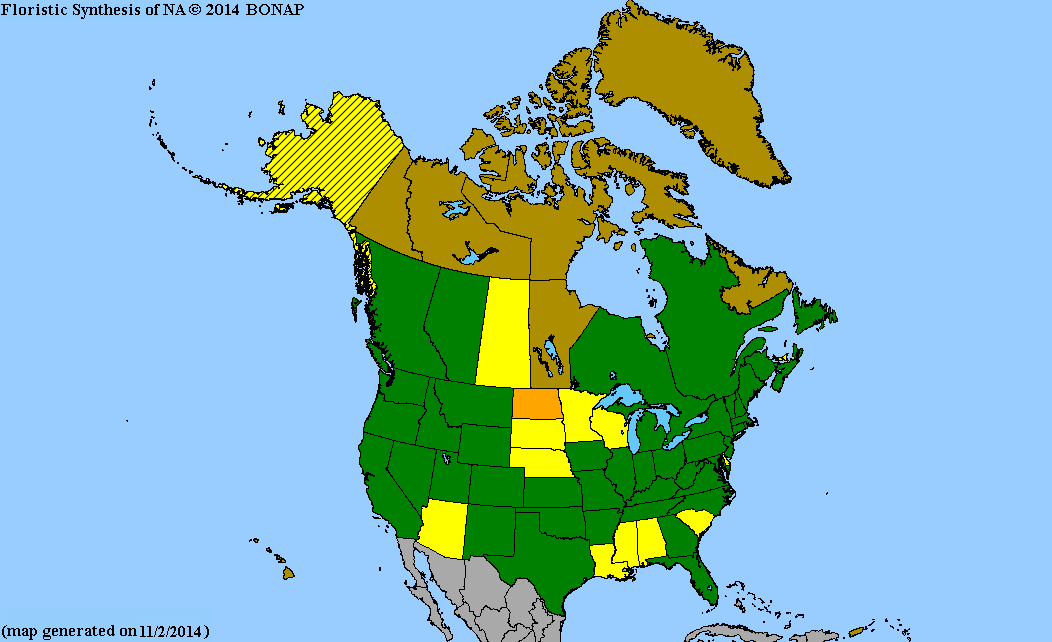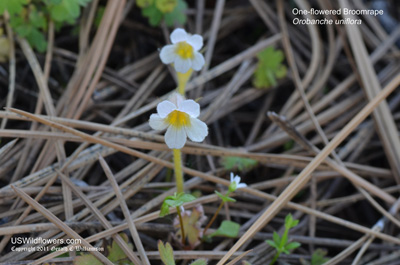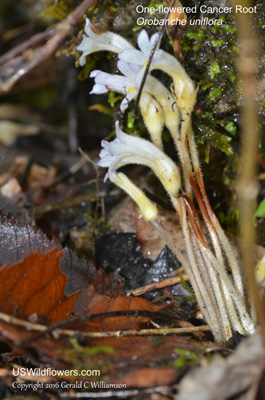Wildflowers of the United States | |||||||||||||
| |||||||||||||
Orobanche uniflora - One-flowered Broomrape ; One-flowered Cancer Root, Ghostpipe, Naked Broomrape. Not having knowingly encountered this parasitic plant previously, I was surprised to find that it is found in every state in the United States except for Hawaii. It's also found in much of Canada. It may attach its feeder roots to the roots of many different species of plants.
| Plants of the genus Orobanche are classified as a noxious weed or similar pest plant in the United States federally and in 9 states specifically, but there is an exception for native species in all cases but two states (Massachusetts and Florida), and Florida specifically excludes Orobanche uniflora from its noxious weed list, which leaves only Massachusetts with a negative classification for One-flowered Broomrape. An explanation of the somewhat unfortunate name is probably appropriate. "Broom" is an old-world name for vetches and other similar legumes, which are among the plants which Orobanche parasitize. A "rapum" is a term for a knob of roots, to which Orobanche attach to perform their nefarious parisitic activities. Synonyms: Thalesia uniflora, Aphyllon uniflorum, Orobanche porphyrantha, Orobanche purpurea, Orobanche sedii, Orobanche terrae-novae. Weakley classifies this plant as Aphyllon uniflorum in his esteemed Flora of the Southern and Mid-Atlantic States (2015), and that change - return; it has bounced between Orobanche and Aphyllon over the years since 1753 - that change seems to be generally accepted now based on a paper published in 2016 by Adam C. Schneider. Found in: AK, AL, AR, AZ, CA, CO, CT, DC, DE, FL, GA, IA, ID, IL, IN, KS, KY, LA, MA, MD, ME, MI, MN, MO, MS, MT, NC, ND, NE, NH, NJ, NM, NV, NY, OH, OK, OR, PA, RI, SC, SD, TN, TX, UT, VA, VT, WA, WI, WV, WY Leave comments on Orobanche uniflora at this link.   Map courtesy of The Biota of North America Program. Map color key Search Our Database: Enter any portion of the Scientific, Common Name, or both. Do a general Google search of the entire site: #ad
| #ad
| | ||||||||||
|
Commercial / Cookie Notice Looking for Wildflowers for a specific state? Check here: | |||||||||||||
|
All content except USDA Plants Database map Copyright Gerald C. Williamson 2024 | |||||||||||||
Code Update 20230302



